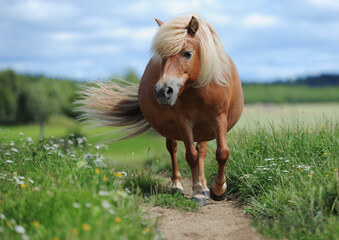How to Measure Energy in Your Horse’s Diet
By Eleanor Blazer
 The calculations for the amount of energy in your horse’s diet (and yours) are based on a platinum-iridium bar made in 1885. That bar weighs exactly one kilogram (1,000 grams or about 2.2 pounds). It is kept at the International Bureau of Weights and Measures near Paris, France. Copies of the bar are kept at various governmental weights and measures agencies around the world.
The calculations for the amount of energy in your horse’s diet (and yours) are based on a platinum-iridium bar made in 1885. That bar weighs exactly one kilogram (1,000 grams or about 2.2 pounds). It is kept at the International Bureau of Weights and Measures near Paris, France. Copies of the bar are kept at various governmental weights and measures agencies around the world.
What does that bar have to do with energy in a diet? It is the international standard for the metric system. The metric system is used in nutrition calculations.
When measuring energy in food or feed we measure the calories. A calorie (spelled with a lowercase c) represents the amount of energy it takes to raise one gram of water one degree Celsius (1.8 degrees Fahrenheit). A Calorie (spelled with a capital C) represents the amount of energy it takes to raise one kilogram (1,000 grams) of water one degree Celsius. The Calorie is also called a kilocalorie. This is the rate of measurement used in human nutrition. Often, it’s incorrectly spelled.
A megacalorie (Mcal) is 1,000 kilocalories. Megacalorie is the rate of measurement used to measure energy in a large animal’s diet, such as the horse.
How do we know the horse is getting enough megacalories? The easiest method is to look at him. If he is thin, he’s not getting enough and if he’s fat he is getting too many megacalories. This is not really scientific—but it works. It’s now up to you to adjust his feed quantity and quality.
If you want a more scientific approach, the hay needs to be tested and the grain researched. The hay test must be conducted with the equine digestive system in mind. The laboratory needs to know the hay sample is for horse consumption. Horses utilize energy differently than ruminant animals (cattle).
Once the hay test is completed, the results will show the digestible energy in the hay. It will appear on the test as “DE, equine Mcal/lb.” For example, if the test reports a reading of 0.78 DE, equine Mcal/lb it means each pound of hay will offer 0.78 megacalories.
An adult 1,100-pound horse that is doing moderate activity needs approximately 24.6 Mcals per day. Divide 24.6 by 0.78 which equals 31.5 pounds of hay. It will be very difficult for a horse to eat that much hay. Better hay needs to be found (the best thing to do) or a concentrate needs to be fed.
Most of the time megacalories are not stated on the feed tag. A call to the manufacturer might help but depending on the company the success of finding out varies. A visit to the manufacturer’s website might give some insight. But be careful—most do not know the difference between calories, Calories or megacalories. You may have to do the math.
The feed tag can give you an idea of the energy level of the ration. If the product is designed for adult horses at maintenance activity level it will have lower megacalories than a feed designed for performance horses or young growing horses. Choose the feed designed for your horse and follow the feeding directions.
It’s amazing that a little bar in France can affect so many.
© 2019 The Way of Horses
* Earn a Bachelor of Science Degree in Equine Studies or certification as a Professional Horse Trainer or Riding Instructor. Start your new career as a riding instructor, horse trainer, or stable manager. All courses are online. Visit www.horsecoursesonline.com for information.

Eleanor Blazer was raised training and caring for horses. She learned to ride and care for the horses her family bought and sold. Many of these horses required improved nutrition when they arrived for training. Eleanor’s experience and research has benefited both horses and horse lovers in the field of equine nutrition. An equine nutrition consultant, based in Bulverde, Texas, she keeps busy doing equine nutrition consultations, conducting seminars, and speaking to youth groups about horse care and nutrition. Eleanor is the author of the syndicated column The Way of Horses. She has more than 20 years experience helping and being a mentor to those wanting to know how to provide the very best care and nutrition for our special friend – the horse.

